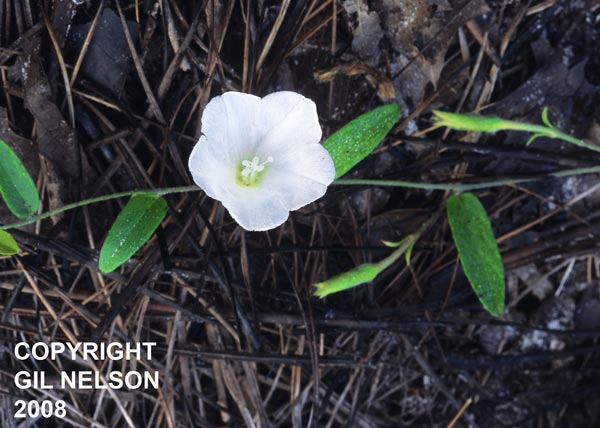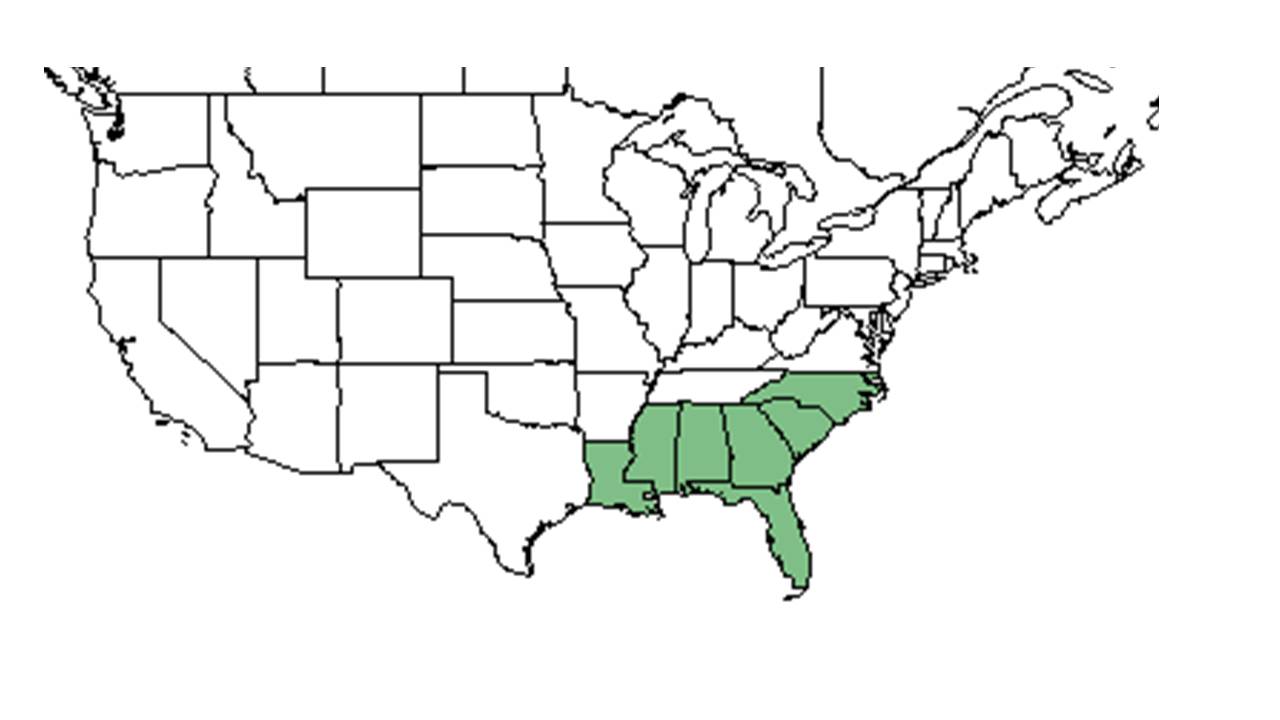Difference between revisions of "Stylisma patens"
Juliec4335 (talk | contribs) |
Juliec4335 (talk | contribs) |
||
| Line 30: | Line 30: | ||
In the Coastal Plains, ''S. patens'' has been documented in a longleaf pine-mixed oak-wiregrass association on a sandy hill slope; frequently burned, mature longleaf pine-wiregrass community; sand of open pine/oak flatwoods; sandhills; edge of longleaf-slash pine/wiregrass community; oak scrub; high turkey oak sandhill; cyrpess depressions in flatwoods; sandy upland pine-oak forests; turkey oak-wiregrass community; upland pinewoods; and longleaf pine-oak barrens. <ref name="FSU Herbarium">Florida State University Robert K. Godfrey Herbarium database. URL: [http://herbarium.bio.fsu.edu http://herbarium.bio.fsu.edu]. Last accessed: July 2015. Collectors: R. A. Norris, Robert K. Godfrey, Loran C. Anderson, Cecil R Slaughter, Gil Nelson, W. W. Baker, R. R. Smith, T. Myint, R. Buchanan, S. W. Leonard, Robert Kral, Mable Kral, R. L. Lazor, Jean Wooten, Patricia Elliot, Sidney McDaniel, William Reese, Paul Redfearn, A. E. Radford, D. S. Correll, D. B. Ward, B. Moore, Walter S. Judd, A. F. Clewell, J. Beckner, Olga Lakela, E. West, Lovett E. Williams, S. B. Jones, M. L. Fernald, C. Ritchie Bell, O. M. Freeman. States and Counties: Florida: Bay, Calhoun, Citrus, Duval, Flagler, Franklin, Gadsden, Gilchrist, Gulf, Hernando, Hillsborough, Jackson, Jefferson, Lafayette, Leon, Liberty, Madison, Marion, Nassau, Putnam, Taylor, Wakulla, Washington. Compiled by Tall Timbers Research Station and Land Conservancy.</ref> In disturbed habitats it has been found in boggy powerline corridors, moderately disturbed longleaf pine restoration sites, dry powerline corridors, sandy roadsides, turkey oak barren clearing, bulldozed scrub oak sandhills, and gravel pits. Soil types include sand and loamy sand. <ref name="FSU Herbarium"/> Associated species include ''Liatris, Erianthus, Gymnopogon, Rhynchospora, Paronychia'', and ''Dyschoriste.'' <ref name="FSU Herbarium"/> | In the Coastal Plains, ''S. patens'' has been documented in a longleaf pine-mixed oak-wiregrass association on a sandy hill slope; frequently burned, mature longleaf pine-wiregrass community; sand of open pine/oak flatwoods; sandhills; edge of longleaf-slash pine/wiregrass community; oak scrub; high turkey oak sandhill; cyrpess depressions in flatwoods; sandy upland pine-oak forests; turkey oak-wiregrass community; upland pinewoods; and longleaf pine-oak barrens. <ref name="FSU Herbarium">Florida State University Robert K. Godfrey Herbarium database. URL: [http://herbarium.bio.fsu.edu http://herbarium.bio.fsu.edu]. Last accessed: July 2015. Collectors: R. A. Norris, Robert K. Godfrey, Loran C. Anderson, Cecil R Slaughter, Gil Nelson, W. W. Baker, R. R. Smith, T. Myint, R. Buchanan, S. W. Leonard, Robert Kral, Mable Kral, R. L. Lazor, Jean Wooten, Patricia Elliot, Sidney McDaniel, William Reese, Paul Redfearn, A. E. Radford, D. S. Correll, D. B. Ward, B. Moore, Walter S. Judd, A. F. Clewell, J. Beckner, Olga Lakela, E. West, Lovett E. Williams, S. B. Jones, M. L. Fernald, C. Ritchie Bell, O. M. Freeman. States and Counties: Florida: Bay, Calhoun, Citrus, Duval, Flagler, Franklin, Gadsden, Gilchrist, Gulf, Hernando, Hillsborough, Jackson, Jefferson, Lafayette, Leon, Liberty, Madison, Marion, Nassau, Putnam, Taylor, Wakulla, Washington. Compiled by Tall Timbers Research Station and Land Conservancy.</ref> In disturbed habitats it has been found in boggy powerline corridors, moderately disturbed longleaf pine restoration sites, dry powerline corridors, sandy roadsides, turkey oak barren clearing, bulldozed scrub oak sandhills, and gravel pits. Soil types include sand and loamy sand. <ref name="FSU Herbarium"/> Associated species include ''Liatris, Erianthus, Gymnopogon, Rhynchospora, Paronychia'', and ''Dyschoriste.'' <ref name="FSU Herbarium"/> | ||
| − | ''Stylisma patens'' var. ''patens'' is frequent and abundant in the Panhandle Xeric Sandhills community | + | ''Stylisma patens'' var. ''patens'' is frequent and abundant in the Panhandle Xeric Sandhills and North Florida Subxeric Sandhills community types as described in Carr et al. (2010).<ref>Carr, S.C., K.M. Robertson, and R.K. Peet. 2010. A vegetation classification of fire-dependent pinelands of Florida. Castanea 75:153-189.</ref> |
===Phenology=== <!--Timing off flowering, fruiting, seed dispersal, and environmental triggers. Cite PanFlora website if appropriate: http://www.gilnelson.com/PanFlora/ --> | ===Phenology=== <!--Timing off flowering, fruiting, seed dispersal, and environmental triggers. Cite PanFlora website if appropriate: http://www.gilnelson.com/PanFlora/ --> | ||
Revision as of 16:19, 20 July 2020
| Stylisma patens | |
|---|---|

| |
| Photo taken by Gil Nelson | |
| Scientific classification | |
| Kingdom: | Plantae |
| Division: | Magnoliophyta – Flowering plants |
| Class: | Magnoliopsida – Dicotyledons |
| Order: | Solanales |
| Family: | Convolvulaceae |
| Genus: | Stylisma |
| Species: | S. patens |
| Binomial name | |
| Stylisma patens (Desr.) Myint | |

| |
| Natural range of Stylisma patens from USDA NRCS Plants Database. | |
Common names: Coastal Plain dawnflower, Common dawnflower
Contents
Taxonomic notes
Synonyms: Stylisma patens (Desrousseaux) Myint ssp. patens; Bonamia patens (Desrousseaux) Shinners var. patens; Stylisma patens (Desrousseaux) Myint var. patens; Bonamia aquatica (Walter) A. Gray
Description
Distribution
Ecology
Habitat
In the Coastal Plains, S. patens has been documented in a longleaf pine-mixed oak-wiregrass association on a sandy hill slope; frequently burned, mature longleaf pine-wiregrass community; sand of open pine/oak flatwoods; sandhills; edge of longleaf-slash pine/wiregrass community; oak scrub; high turkey oak sandhill; cyrpess depressions in flatwoods; sandy upland pine-oak forests; turkey oak-wiregrass community; upland pinewoods; and longleaf pine-oak barrens. [1] In disturbed habitats it has been found in boggy powerline corridors, moderately disturbed longleaf pine restoration sites, dry powerline corridors, sandy roadsides, turkey oak barren clearing, bulldozed scrub oak sandhills, and gravel pits. Soil types include sand and loamy sand. [1] Associated species include Liatris, Erianthus, Gymnopogon, Rhynchospora, Paronychia, and Dyschoriste. [1]
Stylisma patens var. patens is frequent and abundant in the Panhandle Xeric Sandhills and North Florida Subxeric Sandhills community types as described in Carr et al. (2010).[2]
Phenology
S. patens has been observed flowering May through September with peak inflorescence in June and fruiting May through November.[1][3]
Seed dispersal
This species is thought to be dispersed by gravity. [4]
Conservation and management
Cultivation and restoration
Photo Gallery
References and notes
- ↑ 1.0 1.1 1.2 1.3 Florida State University Robert K. Godfrey Herbarium database. URL: http://herbarium.bio.fsu.edu. Last accessed: July 2015. Collectors: R. A. Norris, Robert K. Godfrey, Loran C. Anderson, Cecil R Slaughter, Gil Nelson, W. W. Baker, R. R. Smith, T. Myint, R. Buchanan, S. W. Leonard, Robert Kral, Mable Kral, R. L. Lazor, Jean Wooten, Patricia Elliot, Sidney McDaniel, William Reese, Paul Redfearn, A. E. Radford, D. S. Correll, D. B. Ward, B. Moore, Walter S. Judd, A. F. Clewell, J. Beckner, Olga Lakela, E. West, Lovett E. Williams, S. B. Jones, M. L. Fernald, C. Ritchie Bell, O. M. Freeman. States and Counties: Florida: Bay, Calhoun, Citrus, Duval, Flagler, Franklin, Gadsden, Gilchrist, Gulf, Hernando, Hillsborough, Jackson, Jefferson, Lafayette, Leon, Liberty, Madison, Marion, Nassau, Putnam, Taylor, Wakulla, Washington. Compiled by Tall Timbers Research Station and Land Conservancy.
- ↑ Carr, S.C., K.M. Robertson, and R.K. Peet. 2010. A vegetation classification of fire-dependent pinelands of Florida. Castanea 75:153-189.
- ↑ Nelson, G. PanFlora: Plant data for the eastern United States with emphasis on the Southeastern Coastal Plains, Florida, and the Florida Panhandle. www.gilnelson.com/PanFlora/ Accessed: 14 DEC 2016
- ↑ Kirkman, L. Katherine. Unpublished database of seed dispersal mode of plants found in Coastal Plain longleaf pine-grasslands of the Jones Ecological Research Center, Georgia.